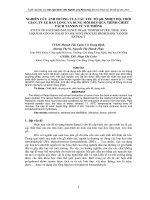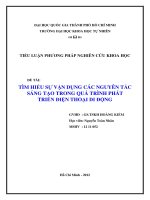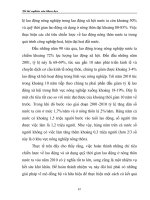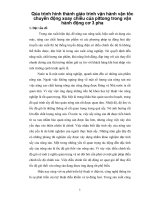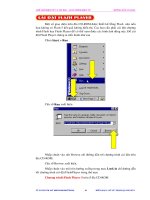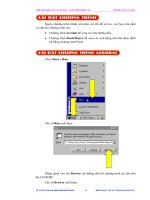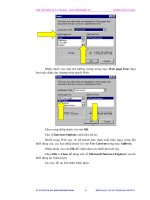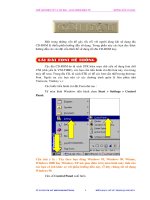Quá trình hình thành giáo trình chuyên ngành điện tử viễn thông - mạng điện thoại tiếng anh chuyên ngành p5 docx
Bạn đang xem bản rút gọn của tài liệu. Xem và tải ngay bản đầy đủ của tài liệu tại đây (220.37 KB, 8 trang )
Unit 3. The Basic Transmission Systems
31
UNIT 3. THE BASIC TRANSMISSION SYSTEMS
I. GIỚI THIỆU
Bài 3 giới thiệu về các hệ thống truyền dẫn cơ bản trong mạng điện thoại.
1. Mục đích yêu cầu
Sau khi nghiên cứu bài 3, sinh viên cần:
1. Nắm được cách mô tả một quá trình.
2. Thành lập câu sử dụng cấu trúc so sánh để giải thích các mối tương quan giữa các yếu
tố.
3. Thành lập hội thoại với các cấu trúc được sử dụng khi bạn hỏi thông tin, yêu cầ
u giải
thích, cho lời giải thích, tỏ ý hiểu.
4. Biết được các phương pháp truyền dẫn lưu lượng điện thoại cơ bản.
5. Biết được các thông tin cơ bản về điều chế xung mã (PCM).
2. Tóm tắt nội dung
1. Khi mô tả một quá trình có 2 điểm cần lưu ý:
- dùng thời hiện tại đơn (chủ động hoặc bị động)
- sử dụng các liên t
ừ (sequence markers).
2. Giải thích các mối tương quan
The greater the …, the larger the …
The greater the …, the higher the …
be double/ twice/ two times/ half/ a half of
Chú ý: khi nói về “mức độ” (degree) hay “tần số” (frequency) ta thường dùng “higher”
hay “lower”.
3. Questions for information → Responses
Questions for explanation → Giving explanations
Showing understanding
4. Các phương pháp truyền dẫn lưu lượng điện thoại cơ bản: truyền dẫn bằng đường dây
trần, cáp treo, cáp ngầm, cáp đồng trục, vệ tinh.
5. Quá trình ước lượng giá trị của mẫu theo một mức mã hoá gọi là “lượng tử hoá” và toàn
bộ quá trình lấy mẫu và mã hoá
được gọi là điều chế xung mã (PCM).
II. NỘI DUNG
1. READING 1
Many different transmission systems are used in telecommunications technology.
Transmission on open-wire lines was the earliest method used for telephone traffic, and this
Unit 3. The Basic Transmission Systems
32
method is still used in the local networks of many countries. Nowadays, due to the demands on
operating reliability, local networks are built up using aerial or underground cable.
Between the subscriber and the local exchange two-wire circuits are used, often placed in
symmetric cable pairs. Between the local and transit exchanges either two- or four-wire circuits
are used. On longer routes, it may be advantageous to use PCM on coaxial cable.
These cables are also used for FDM systems transmitting up to 10 800 telephone channels.
At regular intervals along the coaxial line, line amplifiers are provided; these are mounted in
underground housings and are called “intermediate repeaters”. In principle, the greater the number
of channels transmitted, the larger the number of repeaters required.
Since 1965, satellites have become increasingly important for long distance
communication, especially across the oceans. In principle, the satellite operates as an intermediate
repeater, signals are received, amplified and transmitted to the ground station on the receive side.
Satellites use the same frequency band as radio relay systems.
Radio relay links operate with line of sight between the send and receive stations. In
principle, the greater the diameter of the parabola in relation to the wavelength, the higher the
degree of directivity.
In terminal repeater stations, situated in ground stations and transit exchanges, speech
signals are modulated and combined before transmission. Each separate conversation is shifted to
a significantly higher frequency range. This is done in a number of steps. First, by selecting
suitable modulation frequencies, the conversations can be placed next to each other along the
frequency axis. Then, they are transmitted as a group to the receive side where a similar station
demodulates the signals and extracts the various conversations before they are transmitted in two-
or four-wire circuits to another transit exchange.
1.1. Main phrases
- transmission on open-wire lines: truyền dẫn trên dây trần
- the same … as…: giống như là
- Transmission on open-wire lines was the earliest method used
for telephone traffic:
Truyền dẫn trên dây trần là phương pháp sớm nhất được dùng
để tải …
- Local networks are built up using
aerial or underground cable: Mạng nội hạt được xây
dựng sử dụng
cáp …
- … either
two or four wire circuits are used: … hoặc những mạch 2 dây hoặc 4 dây được
sử dụng
Unit 3. The Basic Transmission Systems
33
1.2. Decide if the statements are true or false.
T/F 1. Local networks are built up using cable rather than open wire.
T/F 2. Aerial cables are used for systems which transmit up to 10 800 telephone channels.
T/F 3. “Line amplifiers” is another term for “intermediate repeaters”.
T/F 4. A satellite has got two functions.
T/F 5. The directivity of a radio relay system is proportional to the diameter of the parabola in
relation to the wavelength.
1.3. This is the simple process description of the function of a terminal repeater station. Put
the sentences in the right order.
• transmission to another transit exchange
• transmission as a group to the receive side
• placing of signal on frequency axis
• demodulation of signals
• extraction of conversations
2. LANGUAGE PRACTICE
2.1. Process description
Hãy xem sự mô tả sơ lược các quá trình sau:
► The height of the pulse is measured
► and (it is) given a binary code.
► Each code is then transmitted as the train of pulses.
► First, by selecting suitable modulation frequencies.
► the conversations can be placed next to each other.
► Then, they are transmitted as a group to the receive side.
► Where a similar station demulates the signals
► and extracts the various conversations,
► before they are transmitted to another exchange.
Lưu ý 2 đặc điểm:
- Khi mô tả quá trình: thường dùng thời hiện tại đơn, có thể dùng cách nói chủ động hoặc bị
động.
Ví dụ: is measured, are transmitted, extracts
- Để diễn tả các bước trong quá trình, ta sử dụng các liên từ (sequence markers).
Ví dụ: first, then, after that, next, before, finally…
Ta lưu ý khi sử dụng các liên từ và từ “and” để tránh lặp lại. Bước thứ nhất thường dùng từ “first”
ở đầu câu, những bước tiếp theo có thể dùng những từ “then, after that, next,…”, ở bước cuối
cùng có thể sử dụng từ “finally” hoặc thậm chí “before”.
Ví dụ: before they are transmitted to another exchange
Unit 3. The Basic Transmission Systems
34
Practice 2.1. A. Describe the processes by making full sentences (using the active way).
* subscriber A/ lift/ the handset
* wait for/ the dialling tone
* dial/ the number
* hear/ the ringing tone
* subscriber B/ pick up/ the receiver
* conversation/ take place
* the two subscribers/ replace/ the handsets
Practice 2.1. B. Describe the processes by making full sentences (using the passive way).
* the handset/ lift
* a signal/ send/ the exchange
* the exchange/ send/ a dialling tone
* the number/ dial
* subscriber B number/ select/ in the exchange
* subscriber A number/ connect/ subscriber B number
* conversation/ take place
* handsets/ replace
* connection/ break
2.2. Questions and
Responses
* Question for information
- Khi muốn biết thông tin về điều gì ta có thể hỏi câu hỏi bắt đầu bằng “Can you…?” hoặc “Could
you …?”
Can you give me some background information about …?
- Khi muốn hỏi về khoảng cách thời gian thực hiện công việc nào đó ta bắt đầu bằng “How
often ”.
How often does it need to be sampled?
How often do you phone me?
* Question for explanation
- Khi không rõ điều gì ta có thể đề nghị người khác giải thích thêm.
What do you mean by …?
Ví dụ: Khi nghe thấy người nói đề cập tới PCM nhưng ta không hiểu PCM là gì, ta có thể hỏi:
What do you mean by PCM?
- Khi muốn phân biệt v
ật này với vật kia, ta có thể sử dụng cấu trúc: “What is the difference
between … and …?
Ví dụ: Khi nghe nói về kỹ thuật số và kỹ thuật tương tự, ta không phân biệt được 2 khái niệm này,
ta có thể hỏi:
What is the difference between analogue and digital technique?
Unit 3. The Basic Transmission Systems
35
* Responses
Sau khi người nghe đưa ra đề nghị và ta đồng ý giúp đỡ thì có thể giải thích, bắt đầu bằng: Of
course. As you know… Hoặc bắt đầu bằng:
(That’s a) good question.
I was just coming to that.
* Giving explanations
Khi ta đưa ra cách giải thích khác cho 1 vấn đề, ta có thể nói:
In other words…
Hoặc ta có thể giảng giải thêm với hình vẽ minh hoạ:
You’ll notice … shown in black
* Showing understanding
Sau khi người nói giải thích xong và vấn đề đã rõ ràng, ta có thể nói:
Thank you, that’s a lot clearer.
Practice 2.2. Put the sentences or phrases into the right group.
1. Questions for information
2. Questions for explanation
3. Responses
4. Giving explanations
5. Showing understanding
a. Could you give me some background information about pulse code modulation?
b. How often does it need to be sampled?
c. Thank you, that’s a lot clearer.
d. What do you mean by analogue?
e. Of course.
f. As you know in the simplest telephone system, speech is converted into electrical energy.
g. Well, analogue means that the current has the same waveform as the variations in air
pressure
h. I was just coming to that.
i. In other words…
j. As you can see on the graph, the vertical axis is either current or air pressure.
k. Let’s look at this graph.
l. You'll notice the gaps between the pulses.
m. I see.
n. That’s a good question.
o. So, that’s what PCM is.
p. Let's look at this block schematic diagram.
Unit 3. The Basic Transmission Systems
36
3. READING 2
Customers’ complaints
• A “I waste hours trying to get through. No one ever seems to answer the phone.”
• B “I run my business on my own. I’ve no secretary. I’m out a lot and my customers get
fed up listening to my telephone answering machine.”
• C “We must spend a fortune on international calls. You get through to a big company’s
switchboard and then you are left listening to the phone ringing in someone’s office. After
a minute or so, you put the phone down and call the switchboard again!”
• D “The phone’s always engaged. I keep trying but never seem to catch you when you’re
not already on the phone.”
• E “I would like to use the phone more for bookings but it costs so much. If you call long
distance in the day, it’ll cost you a fortune!”
Common Channel Signalling and the subscriber
During recent years, the dramatic progress made in the field of telecommunications has
paved the way for the introduction of new and improved services. It will be of vital importance for
TA’s to be able to satisfy customer demands regarding such services. Whatever new services
come, and regardless of their implementation, one thing is certain: they will require signalling
resources which cannot possibly be provided by the conventional signalling systems in use today.
With conventional signalling, a large number of pieces and many types of signalling
equipment are required. With Common Channel Signalling (CCS), the signalling equipment is
limited to relatively few signalling links. These links are used for the transfer of signalling
messages between SPC exchanges. One link can be used for signalling many simultaneous
transactions and hence is called a “common channel”. The signalling information is digitally
coded and transmitted in the form of discrete block of binary coded data. Each message is
logically associated with the transaction concerned (e.g. the set up of a call on a certain circuit) by
means of a label (address).
To summarize, CCS makes it possible to transfer signalling information directly from one
digital exchange to another without setting up a speech-path.
3.1. Main phrases
- be of vital importance for : diều quan trọng sống còn/ đặc biệt quan trọng đối với
- label = address: nhãn, địa chỉ
3.2. a. Look back at the customers’ complaints. Match the following service with their
problems (A - E)
i) Call to busy subscriber
ii) Diversion to subscriber
iii) INWATS (Inward Wide-Area Telephone Service)
iv) Diversion on no reply
Unit 3. The Basic Transmission Systems
37
v) Call diversion
b. Choose the right answer.
With Common Channel Signalling (CCS),
i) many types of signalling equipment are required.
ii) few signalling links are required.
4. LISTENING
Listen to the following extract from a training session in which an instructor is being asked about
PCM.
4.1. Decide if the statements are true or false.
T/F 1. Electrical energy is speech in its raw state.
T/F 2. Mechanical energy is speech converted into for transmission.
T/F 3. More than 24 channels can be carried.
T/F 4. PAM pulses are not transmitted directly because they would become distorted.
4.2. Choose the right answers.
a. What is the best definition of the word “analogue”?
i) the form of waves
ii) something similar to something else
iii) something that can be analysed
b. If the highest frequency is 4 800 Hz, what should the sampling rate be?
i) 4 800 samples per second
ii) 10 000 samples per second
iii) 7 200 samples per second
c. What is the best definition of “quantization”?
i) the process of sampling and coding sound waves
ii) the process of measuring the height of a waveform
iii) the process of measuring the height and giving it a coded level
III. TÓM TẮT
1. Cách mô tả một quá trình.
2. Thành lập câu sử dụng cấu trúc so sánh để giải thích các mối tương quan giữa các yếu
tố.
3. Thành lập hội thoại với các cấu trúc được sử dụng khi bạn hỏi thông tin, yêu cầu giải
thích, cho lời giải thích, tỏ
ý hiểu.
4. Các phương pháp truyền dẫn lưu lượng điện thoại cơ bản.
5. Điều chế xung mã (PCM).
Unit 3. The Basic Transmission Systems
38
VOCABULARY
aerial cable n cáp treo
binary code n mã nhị phân
channel n kênh
current n dòng điện
degree of directivity n độ định hướng
dialling tone n âm (tín hiệu) mời quay số
diameter n đường kính
frequency band n băng tần
ground station n trạm mặt đất
handset / receiver n ống nghe, tổ hợp
intermediate repeater n bộ lặp trung gian
interval n khoảng cách
line amplifier n bộ khuyếch đại đường dây
line of sight n tuyến ngắm, tầm nhìn thẳng
parabola n ăngten parabol
pulse n xung
pulse amplitude modulation (PAM) n điều chế biên độ xung
radio relay link n đường chuyển tiếp vô tuyến
radio relay system n hệ thống chuyể
n tiếp vô tuyến
receive side n phía thu
receive station n trạm thu
ringing tone n tín hiệu chuông reo
sampling rate n tỷ lệ lấy mẫu
send side n phía phát
send station n trạm phát
symmetric cable pair n đôi cáp đối xứng
terminal repeater station n trạm lặp đầu cuối
time slot n khe thời gian
to amplify v khuyếch đại
to break v kết thúc đàm thoại, mất liên lạc
to code v mã hoá
